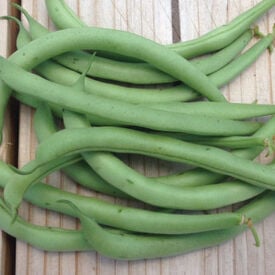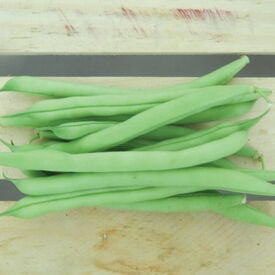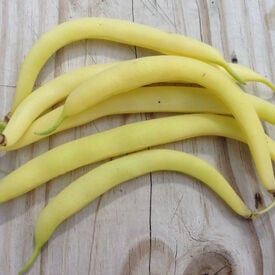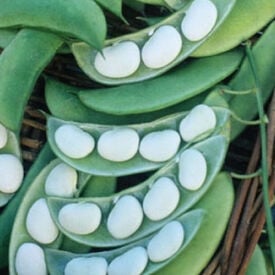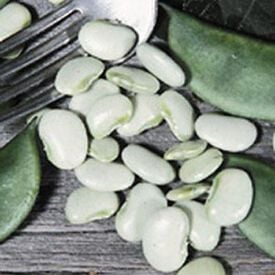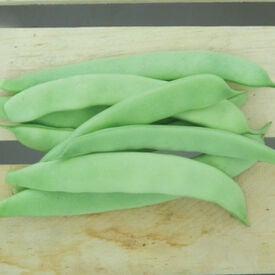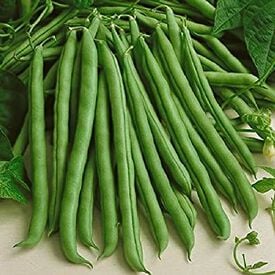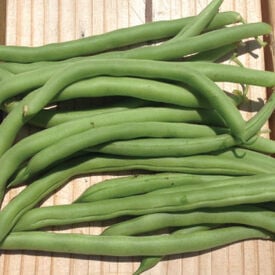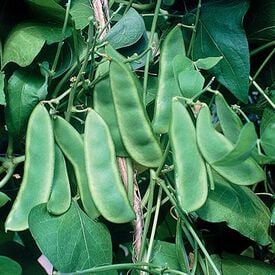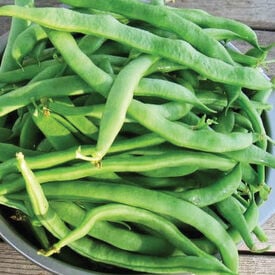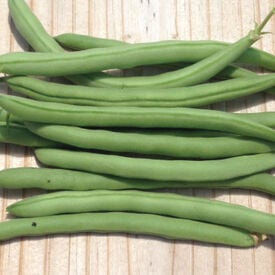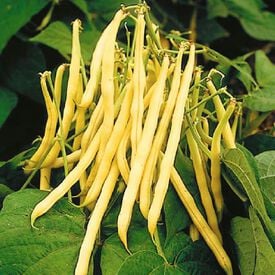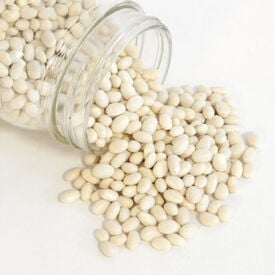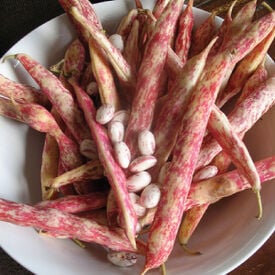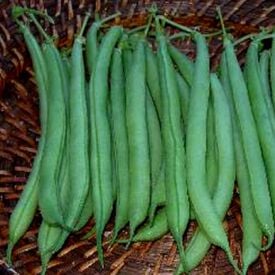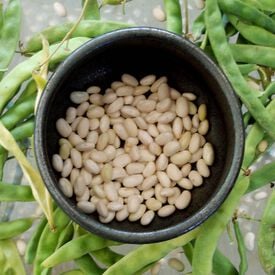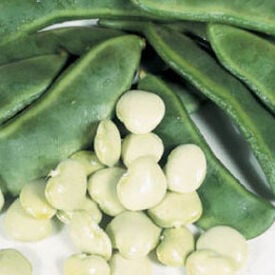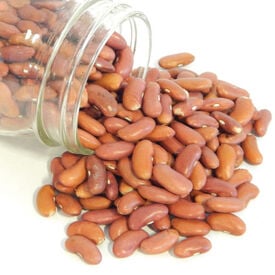Contender beans, scientifically known as Phaseolus vulgaris 'Contender,' are a popular variety of green snap beans that have a rich history and are prized by gardeners for their excellent flavor and productivity. Originating from the United States, Contender beans have been a favorite among home gardeners and commercial growers for many decades. This heirloom variety was first introduced in the 1940s and has since become a classic choice for those looking to cultivate delicious and reliable green beans. Contender beans typically produce uniform, straight pods that range in size from 6 to 7 inches (15 to 18 cm) in length. The pods are slender and tender, making them ideal for fresh consumption, canning, or freezing. The plants themselves are compact and bushy, reaching a height of about 18 to 24 inches (45 to 60 cm), which makes them well-suited for smaller garden spaces or container gardening. In terms of maturity, Contender beans are known for their relatively quick growth. They typically reach maturity in approximately 50 to 55 days after planting. These beans thrive in full sun and well-drained soil with good organic matter content. They are relatively easy to grow and require regular watering to maintain consistent soil moisture. Contender beans are a favorite among gardeners for their reliability, versatility, and the delectable taste of their tender green pods.
The Provider bean is a stringless, fast maturing bush bean. Provider beans can be planted earlier than other beans because it germinates well in cool soils. Provider has compact bean plants that are easy to establish and adapt well to diverse soil and climate conditions. Harvest early for best stringless beans.
Cherokee Wax beans, also known as Cherokee Yellow Wax beans, are a popular variety of bush beans cherished for their vibrant appearance and delicious flavor. These beans are believed to have originated from the Native American Cherokee tribe, hence their name. Cherokee Wax beans are a warm-season vegetable that thrives in various climates, making them a favorite among home gardeners and commercial growers alike. Cherokee Wax beans are known for their exceptional taste, boasting a mild, slightly sweet flavor with a tender and crisp texture. They are a type of bush bean, which means they grow as compact, bushy plants that don't require support structures. The pods of Cherokee Wax beans typically measure around 5 to 6 inches in length and have a bright yellow color. These beans have a relatively short time to maturity, usually taking about 50-55 days from planting to harvest. They are highly productive, yielding an impressive quantity of beans per 10-foot row. In terms of growing conditions, Cherokee Wax beans thrive in well-draining soil that receives full sun exposure. They require spacing of about 3-4 inches between plants and should be sown in rows that are 18-24 inches apart. Cherokee Wax beans are generally disease-resistant, with some varieties exhibiting resistance to common bean diseases like rust and mosaic virus. With proper care and regular harvesting, these beans can provide a bountiful and delicious addition to your garden or dinner table.
The Burpee Improved Bush Lime bean plants produce large pods, high yields, and perfectly shaped beans. Burpee Improved beans are both larger and thicker than normal lima beans. The growth is even more vigorous, with heavier foliage. The plants are uniformly upright.
The Eastland bean, scientifically known as Phaseolus vulgaris 'Eastland,' is a popular variety of bush bean that hails from the United States. It is highly esteemed for its exceptional taste and ease of cultivation. Eastland beans belong to the family Fabaceae and are a warm-season crop commonly grown in gardens and small-scale farms. In terms of taste, Eastland beans are celebrated for their tender, crisp texture and rich, earthy flavor. They are a delight to eat both raw and cooked. The pods of Eastland beans are of medium size, typically measuring around 4-5 inches in length. The plants themselves are compact and bushy, making them suitable for smaller gardens and spaces. These beans have a relatively short maturity period, typically taking around 70-75 days from planting to harvest. The beans are known for their vibrant green color, making them visually appealing as well. Eastland beans are generally resistant to common bean diseases such as bean mosaic virus and rust. They are known to provide a good yield per acre, often ranging from 800 to 1,200 pounds of beans per acre, depending on growing conditions and care. Proper spacing is crucial for their growth, with plants typically spaced 3-4 inches apart in rows that are about 18-24 inches apart. These beans thrive in well-drained soil with full sun exposure and require regular watering to maintain consistent moisture levels in the soil. Overall, Eastland beans are a favorite among gardeners and farmers for their taste, disease resistance, and relatively quick harvest time.
Roma II beans, also known as Romano beans or Italian flat beans, are a popular variety of green beans known for their exceptional flavor and unique appearance. These beans have a rich history dating back to ancient Rome, where they were cultivated and enjoyed for their culinary versatility. Roma II beans are distinct from traditional green beans due to their flat, wide pods and are favored by many for their tender, meaty texture and delicious taste. The taste of Roma II beans is often described as nutty and slightly sweeter than regular green beans, making them a sought-after choice in various culinary dishes. These beans are typically harvested when they are about 4-6 inches long, ensuring optimal tenderness and flavor. The plants of Roma II beans are known to be vigorous and can reach a height of about 18-24 inches. They have a relatively short maturity period, usually taking around 60 days to reach harvest readiness from the time of planting. The pods of Roma II beans are typically a vibrant green color and can grow to be 5-6 inches long. Roma II beans are prized for their resistance to common bean diseases, including common mosaic virus, rust, and bacterial brown spot, which can help ensure a healthy harvest. When properly cared for, these plants can yield a bountiful crop. For optimal growth, Roma II beans should be spaced about 3-4 inches apart in rows that are 18-24 inches apart. They thrive in well-drained soil and require full sun exposure, making them a great addition to any home garden or farm. Overall, Roma II beans are a delightful and versatile choice for those looking to grow and enjoy fresh, flavorful beans.
This green bean was first grown in 1962 in Twin Falls, Idaho. Tenderette is a flavorful, stringless, high-bearing green bean that has a long harvest season. The plant reaches 20" tall and bears long, straight, consistent 5" long green beans. Tenderette has an intense, rich flavor and full of snap. Excellent steamed, stir-fried or even raw.
Blue Lake 274 is a popular variety of green bean (Phaseolus vulgaris) known for its exceptional taste and reliable performance in home gardens and commercial agriculture. This cultivar has a rich history, tracing its origins back to the Blue Lake region in California. Blue Lake 274 beans are beloved for their tender, crisp texture and sweet, earthy flavor, making them a favorite among gardeners and consumers alike. The Blue Lake 274 bean plant typically grows to a height of 18 to 24 inches, with a bushy, compact habit that makes it suitable for both garden beds and containers. It is classified as a bush bean, which means it doesn't require trellising or support structures. This variety is known for its relatively quick maturity, typically taking about 55 to 60 days from planting to harvest. The pods of Blue Lake 274 are long and slender, usually reaching a length of 6 to 7 inches. They are a vibrant green color and are prized for their straightness and uniformity. Blue Lake 274 beans exhibit resistance to common bean diseases such as bean mosaic virus and bean common mosaic virus, which contributes to their reliability and yield consistency. Speaking of yield, you can expect a bountiful harvest from this variety, with each row typically producing around 8 to 10 pounds of beans. For optimal growth, Blue Lake 274 beans thrive in well-drained, fertile soil with a pH level of 6.0 to 6.8. Plant them in rows with spacing of approximately 18 to 24 inches between plants. They require full sun exposure for at least 6 to 8 hours a day and should be watered consistently to keep the soil evenly moist. With the right care and conditions, Blue Lake 274 beans are sure to provide a delicious and productive addition to your garden.
The small Woods Prolific Lima Bean is perfect for canning, freezing and as a dry bean! The bean plant produces thick green pods with small creamy white seeds. Each pod contains about 3 to 4 seeds. The Woods Prolific Lima Bean prefers full sun and has early to mid maturity and produces continuously until frost.
The Kentucky Wonder 125 bean is a wonderful bush bean that is above the others! Kentucky Wonder 125 Bush Bean matures early than most bush beans and produces beans in clusters over a long season. The bush beans’ meaty, medium-green pods are 8 inches and packed with delicious, extra-tasty bean seeds.
The Topcrop bean is a great bean for canning and freezing. Topcrop got its name for a reason. This bean plant grows a heavy, concentrated set of beans. One of the best known beans around. Harvest on the early side of maturity to get small and tender beans. Delicious eaten fresh off the vine!
The Pencil Pod Black Wax bean is a highly productive and long standing bush bean. Also known as 'Eastern Black Wax', these beans are bushy, vigorous, and resistant to rust and mosaic virus. The pods are golden color and grow to 5-7" long. A great all-purpose type, that is great fresh, canned, or frozen. As the name hints, the seeds are black.
Navy beans, scientifically known as Phaseolus vulgaris, are small, oval-shaped beans that are a popular and versatile member of the legume family. They are often referred to as navy beans due to their association with the United States Navy, where they were a staple food for sailors in the 19th century. These beans have a rich history dating back to ancient times when they were cultivated by indigenous peoples in the Americas. They were later introduced to Europe by Spanish explorers and became an essential part of global cuisine. Navy beans have a mild, nutty flavor and a smooth, creamy texture when cooked. They are known for their ability to absorb the flavors of the ingredients they are cooked with, making them a favorite in soups, stews, and baked bean dishes. These beans are typically small, about half an inch in length, and are usually white or off-white in color, although there are variations with speckled or colored coats. In terms of plant characteristics, navy bean plants are relatively compact, reaching a height of about 18 to 24 inches. They have a bushy growth habit and produce small, white or lavender flowers before developing pods that contain the beans. Navy beans typically take around 80 to 90 days to reach maturity, making them a relatively quick-growing crop. They thrive in well-drained soil with good moisture retention and prefer full sun for optimal growth. Adequate spacing and support may be needed to ensure healthy plant development, and they are generally grown as annuals in most regions.
The Vermont Cranberry Shell bean is an incredible bean variety that can be used as a snap, shell or dry bean. Cranberry Shell stores exceptionally well. Maroon colored beans are decorated with darker red, cranberry markings. This variety dates back to the 1800s and is well-suited to short-season, cool summer climates.
Strike beans are one of the heaviest yielding bush beans on the market. Continuous setting feature protects grower from stress, better than concentrated set types. Medium green, 5" round pod with good disease tolerance. Excellent flavor that is very popular with commercial growers.
The great northern bean is an heirloom bean variety that is perfect for drying and using in different baked dishes. Semi-vining, 24 inch plants yield a prolific quantity of flat, 5 inch pods holding 5 to 6, large white beans.
Henderson is the ultimate popular baby Lima. Henderson offers great tasting, smaller beans, that are perfect for cooking with any meal.
The Light Red Kidney Bean is a popular kidney bean that has mild bean flavor! Excellent for chili, bean salads, and soups. Exceptional culinary quality, with silky texture and thin skin. Plants grow to medium size that are sturdy and widely adapted. Produce well anywhere in the United States.
